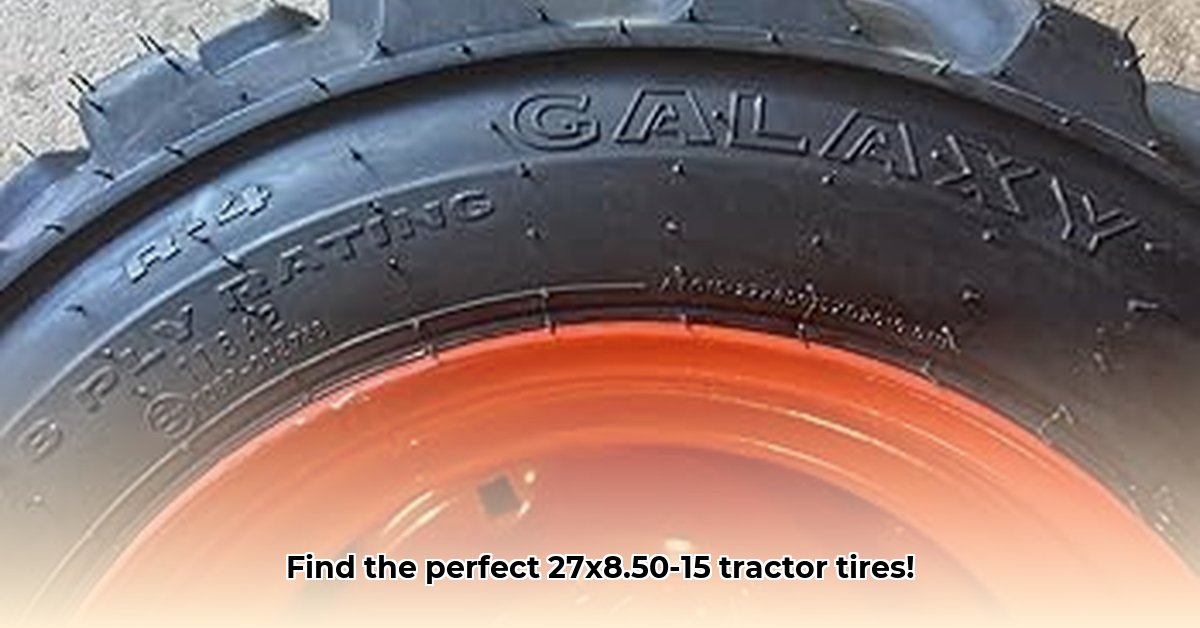
Choosing the right tractor tires significantly impacts farm efficiency and profitability. This guide focuses on 27x8.50-15 tractor tires, providing a comprehensive understanding of selection and maintenance for optimal performance. We'll explore tread patterns, load capacity, durability, and crucial maintenance practices to ensure your tires deliver maximum value. For information on other sizes, check out our guide on different tractor tire sizes.
Decoding Your 27x8.50-15 Tractor Tires: A Technical Overview
The 27x8.50-15 designation isn't arbitrary; it reflects specific tire dimensions and capabilities crucial for agricultural and industrial applications. Let's delve into the key characteristics:
Tread Pattern: Traction and Terrain
The tread pattern significantly influences traction. Deep, aggressive lugs (the raised blocks on the tire) provide exceptional grip in muddy or loose soil, ideal for plowing or fieldwork in wet conditions. Conversely, shallower treads are better suited for hard-packed soil or paved surfaces, offering improved fuel efficiency but potentially sacrificing traction in challenging terrain. Choosing the wrong pattern can lead to reduced productivity and increased fuel consumption. What tread pattern is best suited for your primary soil type?
Load Capacity: Weight and Safety
Load capacity, clearly indicated on the tire's sidewall, represents the maximum weight a tire can safely carry. Exceeding this limit increases wear, risks blowouts, and compromises safety. Always operate within the manufacturer's specified load limits. Have you verified your tractor's weight and load distribution to ensure adequate tire capacity?
Construction and Durability: Building for Longevity
Tire construction significantly influences durability. Reinforced sidewalls and high-quality materials enhance protection against damage from impacts and punctures. While initial cost might be higher, durable tires offer extended lifespan, reducing replacement frequency and long-term costs. How does the tire's construction contribute to its overall lifespan and resilience to damage?
Puncture Resistance: Protecting Against Hazards
Agricultural environments present numerous puncture hazards. Tires with enhanced puncture resistance, often achieved through specialized compounds or reinforced layers, minimize downtime and repair expenses. This feature is particularly valuable in rocky or debris-filled fields. Does your chosen tire offer any specialized features to enhance puncture resistance given your field conditions?
Selecting the Right 27x8.50-15 Tractor Tires: A Practical Guide
Choosing the optimal tires involves a systematic approach. Follow these steps to make an informed decision:
Assess Your Terrain: Identify your primary soil type (clay, sandy loam, etc.). This determines the necessary tread pattern for optimal traction.
Evaluate Workload: Determine your tractor's weight and typical hauling capacity. Ensure the tires' load capacity aligns with these demands.
Establish Budgetary Limits: Set a realistic budget recognizing that higher-quality tires often equate to a longer lifespan and better return on investment.
Compare Specifications and Reviews: Scrutinize manufacturer specifications, paying close attention to load capacity, tread depth, and construction. Consult online reviews for insights from other users.
Seek Expert Advice: Consult with experienced mechanics or agricultural supply dealers for personalized recommendations.
Tire Maintenance: Maximizing Lifespan and Performance
Regular maintenance significantly extends tire life and ensures operational safety.
Maintain Proper Inflation: Regularly check tire pressure using a reliable gauge. Underinflation increases wear, while overinflation weakens the tire structure. Correct pressure is always listed on the tire sidewall.
Regular Inspections: Conduct routine visual inspections for cuts, punctures, unusual wear patterns, or embedded objects. Address minor issues promptly to prevent major problems.
Tire Rotation: Rotate tires regularly (consult your tractor's manual for recommended intervals, typically every 500 operating hours) to ensure even tread wear.
Appropriate Storage: Store unused tires in a cool, dry place, away from direct sunlight and extreme temperatures, protecting them against premature aging and cracking.
Frequently Asked Questions (FAQ)
Q: Can I repair a damaged 27x8.50-15 tire? A: Minor punctures might be repairable by a professional. Significant damage (sidewall tears, major cuts) necessitates replacement.
Q: How often should I rotate my tires? A: Consult your tractor's manual for specific guidance; generally, every 500 operating hours is a good practice.
Q: What are the options for tire recycling? A: Contact local agricultural supply dealerships or waste management facilities for recycling options.
Conclusion: Investing in Operational Success
Investing in high-quality 27x8.50-15 tractor tires is critical for operational efficiency, profitability, and safety. By following this guide, making informed choices, and prioritizing regular maintenance, you'll optimize your tractor's performance and minimize costly downtime. Remember, the right tires are a cornerstone of a successful agricultural operation.